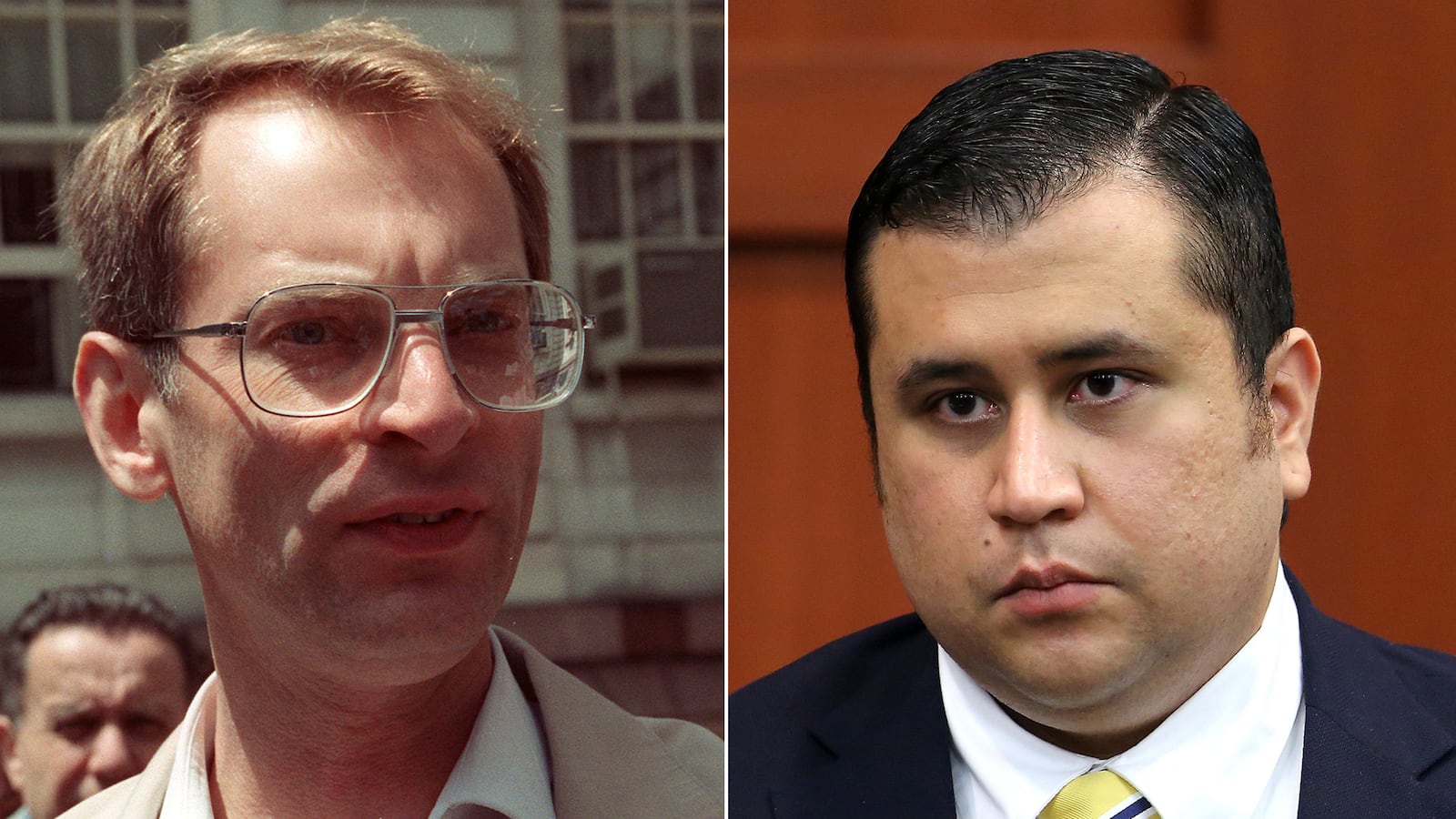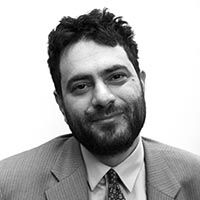“I’m surprised,” said Bernhard Goetz, outside of his 20-story apartment building on Manhattan’s 14th Street, the same street he lived on back in 1984, when he shot four black teenagers on a downtown No. 2 subway train. “I’m surprised the same thing is happening 30 years later. It’s a different place, but the prosecution is the same.”
The man he says “the same thing is happening” to now, George Zimmerman, was just 1 year old in 1984, when Goetz, now 65, “stood his ground” against Barry Allen, Troy Canty, Darrell Cabey, and James Ramseur, friends who had come down from the Bronx to rob video-arcade change boxes. When the mild-looking electrical engineer, who’d been violently robbed before, got on the train at 14th Street, the four boys surrounded him and, after one of them asked him for five dollars, he unloaded his unlicensed revolver, hitting all four of them. He then fled through a tunnel before police arrived, and the identity of the white “subway vigilante” remained a mystery until he turned himself in to the New Hampshire police four days later, offering a dramatic confession that may have shaded into revenge fantasy. All four boys survived, though one was paralyzed, yet Goetz became a folk hero in the eyes of many New Yorkers and Americans at a time when urban crime was widely considered out of control, daylight muggings were commonplace, and the murder rate in Gotham was more than three times what it is today. After a riveting eight-week trial that captured national headlines, and hinged on the question of whether or not he had reason to fear for his life, Goetz was convicted only of criminal possession of a lethal weapon and was sentenced to just six months in prison.
Zimmerman, whose murder trial will conclude Friday when his defense offers its closing argument, was a neighborhood-watch captain in a gated community in Sanford, Fla.—a far cry from mid-1980s Manhattan—last Feburary when he confronted Trayvon Martin, a teenager with no criminal record or history of violent behavior. “These assholes, they always get away,” Zimmerman told a police dispatcher after spotting Martin—before he disregarded the dispatcher’s instructions and got out of his car, with a loaded gun, to confront the teenager who was returning home with a drink and Skittles from a trip to a convenience store during half-time of the NBA All-Star game. That confrontation ended with the two individuals fighting and Zimmerman shooting Martin, who died on the scene. The police, though, released Zimmerman, who claimed self-defense, after just a few hours—before they'd even conclusively identified his victim.
Al Sharpton, who was a vocal critic of Goetz and who also played a leading role in making the Martin case a national story in the weeks after his death, nonetheless agreed with the subway shooter that the two incidents were similar. “When I started seeing the attacks on Trayvon, the criminalizing of wearing a hoodie and other slurs,” like noting the dead boy had smoked marijuana and talked on social networks about fights, said Sharpton, “I thought I was back 30 years ago. Even though Cabey and the others did have [criminal] pasts, Goetz didn’t know that when he shot them on that train. He criminalized them in his mind, those kids 30 years ago. Trayvon is being criminalized now and he doesn’t even have a criminal background and it’s the same kind of profiling.”
But Curtis Sliwa—the founder of the Guardian Angels, the multiracial red-beret-wearing urban patrol group whose members were ubiquitous on trains and elsewhere around 1980s New York, and a prominent ally of Goetz at the time—laughed at the comparison.
“Bernie couldn’t be more totally wrong,” said Sliwa. “He needs to chase some squirrels in the park. This has nothing at all to do with him, nothing in common.
“Bernie Goetz is Charles Bronson in Death Wish,” said Sliwa. “He had enough, and Darrell Cabey represented every guy who had tried to mug him before. George Zimmerman is Travis Bickle in Taxi Driver. He’s a nut. He’s a complete nut job who thinks he’s on a ‘mission,’ and this young black man ended up on his radar screen, and then dead.
“Because I deal with the wannabes who want to join the Guardian Angels, I see right away what this guy Zimmerman is: a self-appointed guardian. It’s him determining who is and is not a threat. Forget laws, forget standards, forget the police. Goetz had already been victimized, thrown thru a plate-glass window (in an attemped day-time robbery on Canal Street in 1981). When the four guys began to surround him on the train, to do that dance that many of us were used to back then, when the predators would sniff you out and maybe they’d rob you but they would empower themselves and you’d be completely emasculated and realize there’s nothing you can do if these guy pounce––but this time he got the jump.”
Those trying to suggest Martin was likewise some sort of thug who brought on his own death because he smoked marijuana or bragged with friends about fighting, “they should impale themselves," said Sliwa. "Here’s a kid, goes out at half-time to get Skittles and iced tea, puts his hoodie on because it’s starting to rain, doesn’t say anything to anybody, isn’t eye-fornicating anybody, just minding his own business. He doesn’t have a M.O. He doesn’t do home invasions. What the hell are you following this kid for? Goddamn right he fights back. The same law that says you can stand and defend yourself in Florida—Martin is defending himself against a guy approaching him with a gun and confronting him.”
“It’s almost the same attack, the same ritual and the same not only demonizing and criminalizing of the victim but trying to make a hero out of the shooter,” said Sharpton. “Goetz became a kind of symbol and even celebrity for shooting kids on the subway. This guy Zimmerman, also well-armed, shooting and killing somebody for nothing. What are we saying to victims and people who feel like victims when people can become heroes and celebrities for shooting and killing us. What do you think we’re saying?
“What America and particularly the media does not understand,” Sharpton continued, “is that makes all of us feel so vulnerable, that we can not only be seen as criminals but be executed as criminals based on somebody’s mind and thoughts—and that makes everybody feel at risk.”
That perspective was shared by the prosecutors of Goetz and now Zimmerman, who warned the respective juries that an acquittal would be read as a license for vigilantism. Both shooters were described to the jury as men who were carrying loaded weapons because they were eager for a confrontation, like the fatal ones they ended up in.
“What turned the tables and made everything backward was that [Goetz defense attorney Barry] Slotnick actually went about prosecuting these four victims,” said Stephen G. Crane, the judge who presided over the case. “He posted their photographs in the well so that the jury was staring at those guys—they could have been prior arrest photos for all I know. They looked menacing. He wanted to create that kind of an atmosphere.” Though Crane said he kept both lawyers from “trotting out the issue of race,” it remained “a 900-pound gorilla in the background.”
Slotnick, who characterized the victims in court as “thugs and hoodlums,” and “predators to society,” credited Goetz's acquittal on all the significant charges to making sure the case was more about chaos and crime than race. “At the end of the day,” he said, “I needed a jury that was racially mixed, and I got that. I got African Americans on that jury, Hispanics, whites and let them know I wasn’t afraid, that I wanted everybody who lived in this terrible, war-torn city to be on this jury.”
The Zimmerman jury, by contrast, is made up of five white women and one Hispanic woman, all over 50, a lack of diversity in a racially-charged case that could “have an influence on the public perception of whatever the verdict turns out to be,” said Crane.
Finally, both cases boil down to the question of whether or not the shooter felt reasonable fear, which in turn is a reflection of the time and place where each shotting took place.
“Oh no,” Sliwa said when asked if he would stand behind Goetz in the same circumstance now. “Today, 2013, it’s Disneyland in comparison. Imagine you’re going back to a time when this city was out of control, when anarchy prevailed, when the gun that Goetz carried––there were a lot of illegal weapons being carried by law-abiding people who just felt it was their only line of defense.”
Alternately, he said, if Zimmerman had shot Martin in exactly the same circumstances 30 years ago, “he would have been given the benefit of the doubt. People would have said, ‘Yeah, that kid was probably up to no good.’ So, Zimmerman’s mind-set was circa 1977 New York City and that’s not 2013 Sanford… He lives in a fantasy make-believe world where there are enemies, potentially predators, lurking everywhere. He’s what we used to call in the neighborhood a screwball.”
Goetz, for his part, declined to say anything further about Zimmerman. “I haven’t owned a TV in 10 years and I don’t listen to the radio!” he said, his hair a little thinner and grayer but otherwise looking very much the same as when he was tabloid-cover material. Then he stepped into his building, ending the brief conversation.
“Actually, he still rides the trains,” said Sliwa. “I’ve come across him and the old timers look, and say, ‘Wow. That’s Bernie Goetz.’ The kids have no idea who he is.”





